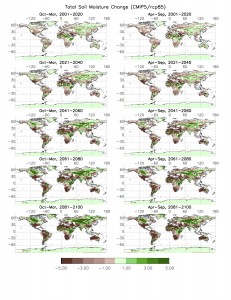Richard Seager’s widely cited 2007 paper projecting “an Imminent Transition to a More Arid Climate in Southwestern North America” did not use the Palmer Drought Severity Index. His work relies on a calculation of precipitation minus evaporation (P – E) to determine the extent and trend of drying under a changing climate. In response to my recent inquiries about the flurry of news involving the question of whether the Palmer shows any global drought trend (background here, here, here) Seager emailed this (shared with permission, linkage added by me, with the plot to which he refers below, click to biggen):
PDSI should not be used for future climate change, pure and simple. The Sheffield paper redoes in many ways a 2008 paper by Eleanor Burke (UK Met. Office) that made the same point about the pitfalls of the simple PET calculations in the PDSI calculation. Indeed Chris Milly has recently made the same point. The problem with the Sheffield paper is it then leaves the impression that there is little to worry about. Not so. Here is an unpublished plot of change in soil moisture for summer and winter half years for the CMIP5 ensemble with the rcp85 scenario – I made % change maps for each model and then averaged the %s to make the multimodel ensemble mean. Bottom line – you still see the widespread drying that PDSI trends indicate though a 10% drop in soil moisture is probably less dramatic in appearance than -10 PDSI.

